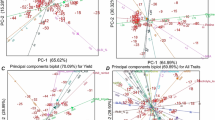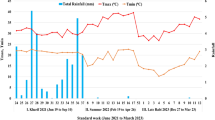Abstract
Chickpea is an important legume, which is mainly planted in the dry season. Drought stress at the end of the season during flowering and pod formation is one of the most important factors limiting production in chickpea. We aimed to investigate the effect of drought stress on yield and related traits, as well as to evaluate and determine the most appropriate indices of drought tolerance in chickpeas. Twenty chickpea genotypes (in 2017–2019) were used as material. The experiment was set up as randomized complete block design under normal and drought conditions. The effect of drought and genotype was significant for all traits. Drought reduced all traits except unfilled pod percentage and canopy temperature traits. Shoot length density and 100-seed weight had the highest direct and positive effect, while days to flowering had the highest negative and significant effect on grain yield. Sixteen previous different drought tolerance indices and two new indices namely: Tolerance Ranking Index (TRI) and Relative Tolerance Index (RTI) were estimated based on grain yield in normal and drought conditions. Based on the results, Harmonic Mean (HAM), Geometric Mean Productivity (GMP), Stress Tolerance Index (STI), TRI and RTI were the best indices to identify tolerant genotypes. TRI and RTI exhibited a positive significant simple correlation with Yp, Ys, HAM, STI and GMP, but their correlations with SSI and Yield Reduction index (YR) were significantly negative. TRI and RTI are powerful to select tolerant genotypes and can be used as indices in the development of QTL populations, due to their association with yield stability under both normal and drought conditions. Also, all superior drought stress indices identified ILC1799, ILC482 and FLIP90-96 as the most tolerant genotypes.






Similar content being viewed by others
References
Arif A, Parveen N, Waheed MQ, Atif RM, Waqar I, Shah TM (2021) A comparative study for assessing the drought-tolerance of chickpea under varying natural growth environments. Front Plant Sci 11:607869. https://doi.org/10.3389/fpls.2020.607869
Arriagada O, Cacciuttolo F, Cabeza RA, Carrasco B, Schwember AR (2022) A comprehensive review on chickpea (Cicer arietinum L.) breeding for abiotic stress tolerance and climate change resilience. Int J Mol Sci 23:6794. https://doi.org/10.3390/ijms23126794
Asati R, Tripathi MK, Tiwari S, Yadav RK, Tripathi N (2022) Molecular breeding and drought tolerance in chickpea. Life 12(11):1846. https://doi.org/10.3390/life12111846
Berger JD, Ali M, Basu PS, Chaudhary BD, Chaturvedi SK, Deshmukh PS, Dharmaraj PS, Dwivedi SK, Gangadhar GC, Gaur PM, Kumar J, Pannu RK, Siddique KHM, Singh DN, Singh DP, Singh SJ, Turner NC, Yadava HS, Yadav SS (2006) Genotype by environment studies demonstrate the critical role of phenology in adaptation of chickpea (Cicer arietinum L.) to high and low yielding environments of India. Field Crops Res 98:230–244. https://doi.org/10.1016/j.fcr.2006.02.007
Blum A (1988) Plant breeding for stress environments. CRC Press. Reprinted in 2018
Devasirvatham V, Tan DKY (2018) Impact of high temperature and drought stresses on chickpea production. Agronomy 8:145. https://doi.org/10.3390/agronomy8080145
Erdemci I (2018) Evaluation of drought tolerance selection indices using grain yield in chickpea (Cicer arietinum L.). Not Sci Biol 10:439–446. https://doi.org/10.15835/nsb10310291
Fahad S, Bajwa AA, Nazir U, Anjum SA, Farooq A, Zohaib A, Sadia S, Nasim W, Adkins S, Saud S, Ihsan MZ, Alharby H, Wu C, Wang D, Huang J (2017) Crop production under drought and heat stress: Plant responses and management options. Front Plant Sci 8:1147. https://doi.org/10.3389/fpls.2017.01147
Fang X, Turner NC, Yan G, Li F, Siddique KHM (2010) Flower numbers, pod production, pollen viability, and pistil function are reduced and flower and pod abortion increased in chickpea (Cicer arietinum L.) under terminal drought. J Exp Bot 61:335–345
FAO (2020) available on [http://faostat.fao.org/]. Retrieved from https://www.fao.org/faostat/en/#data/QC
Farshadfar E, Mahtabi E, Jowkar MM (2017) Evaluation of genotype × environment interaction in chickpea genotypes using path analysis. Int J Adv Biol Biomed Res 5(4):168–173. https://doi.org/10.26655/ijabbr.2017.9.3
Fernandez GCJ (1992) Effective selection criteria for assessing plant stress tolerance. In: International symposium, Adaptation of food crops to temperature and water stress, pp 257–270. Taipei, Taiwan, AVRDC
Fischer RA, Maurer R (1978) Drought resistance in spring wheat cultivars. I. Grain yield responses. Aust J Agric Res 29:897–912
Ganjeali A, Porsa H, Bagheri A (2011) Assessment of Iranian chickpea (Cicer arietinum L.) germplasms for drought tolerance. Agric Water Manag 98:1477–1484
Govindaraj M, Vetriventhan M, Srinivasan M (2015) Importance of genetic diversity assessment in crop plants and its recent advances: an overview of its analytical perspectives. Genet Res Int 2015. https://doi.org/10.1155/2015/431487
Gurumurthy S, Singh J, Basu PS, Meena SK, Rane J, Singh NP, Hazra KK (2022) Increased significance of chickpea (Cicer arietinum L.) senescence trait under water-deficit environment. Environ Chall 8:100565. https://doi.org/10.1016/j.envc.2022.100565
Harish D, Bharadwaj C, Kumar T, Patil BS, Pal M, Hegde VS, Sarker A (2020) Identification of stable drought tolerant landraces of chickpea (Cicer arietinum L.) under multiple environments. Indian J Agric Sci 90:1575–1581. https://doi.org/10.56093/ijas.v90i8.105967
Istanbuli T, Abu Assar A, Tawkaz S, Kumar T, Alsamman AM, Hamwieh A (2022) The interaction between drought stress and nodule formation under multiple environments in chickpea. PLoS ONE 17(10):e0276732. https://doi.org/10.1371/journal.pone.0276732
Jha U, Basu P, Shi S, Singh N (2016) Evaluation of drought tolerance selection indices in chickpea genotypes. Int J Bio-Resour Stress Manag 7:1244–1248
Jha UC, Nayyar H, Jha R, Nath CP, Datta D (2020) Chickpea breeding for abiotic stress: breeding tools and ‘omics’ approaches for enhancing genetic gain. In: Accelerated plant breeding, pp 211–234. https://doi.org/10.1007/978-3-030-47306-8_8
Kanouni H, Shahab MR, Imtiaz M, Khalili M (2012) Genetic variation in drought tolerance in chickpea (Cicer arietinum L.) genotypes. Crop Breed J 2:133–138
Krouma A (2010) Plant water relations and photosynthetic activity in three Tunisian chickpea (Cicer arietinum L.) genotypes subjected to drought. Turk J Agric for 34:257–264
Kumar J, Sen Gupta D, Djalovic I, Kumar S, Siddique KHM (2021) Root-omics for drought tolerance in cool-season grain legumes. Physiologia Plantarum 172:629–644. https://doi.org/10.1111/ppl.13313
Kushwah A, Bhatia D, Singh G, Singh I, Bindra S, Vij S, Singh S (2021) Phenotypic evaluation of genetic variability and selection of yield contributing traits in chickpea recombinant inbred line population under high temperature stress. Physiol Mol Biol Plants 27:747–767. https://doi.org/10.1007/s12298-021-00977-5
Maqbool MA, Aslam M, Ali H (2017) Breeding for improved drought tolerance in Chickpea (Cicer arietinum L.). Plant Breed 136:300–318. https://doi.org/10.1111/pbr.12477
Merga B, Haji J (2019) Economic importance of chickpea: production, value, and world trade. Cogent Food Agric 5(1):1615718. https://doi.org/10.1080/23311932.2019.1615718
Mitra J (2001) Genetics and genetic improvement of drought resistance in crop plants. Curr Sci 80:758–763
Mohammed A, Fikre A (2018) Correlation and path coefficient analysis among seed yield and yield related traits of Ethiopian Chickpea (Cicer arietinum L.) landraces. Berhan Acta Agric Slov 111(3):661–670. https://doi.org/10.14720/aas.2018.111.3.14
Moosavi SS, Samadi BY, Naghavi MR, Zali AA, Dashti H, Pourshahbazi A (2008) Introduction of new indices to identify relative drought tolerance and resistance in wheat genotypes. Desert 12:165–178
Muruiki R, Kimurto P, Vandez V, Gangarao N, Silim S, Siambi M (2018) Effect of drought stress on yield performance of parental chickpea genotypes in semi-arid tropics. J Life Sci 12:159–168. https://doi.org/10.17265/1934-7391/2018.03.006
Özveren Yücel D, Anlarsal AE, Yücel C (2006) Genetic variability, correlation and path analysis of yield, and yield components in chickpea (Cicer arietinum L.). Turk J Agric for 30:183–188
Pang J, Turner NC, Du YL, Colmer TD, Siddique KHM (2017) Pattern of water use and seed yield under terminal drought in chickpea genotypes. Front Plant Sci 8:1375. https://doi.org/10.3389/fpls.2017.01375
Pouresmaeil M, Khavari-Nejad R, Mozafari J, Najafi F, Moradi F, Akbari M (2012) Identification of drought tolerance in chickpea (Cicer arietinum L.) landraces. Crop Breed J 2:101–110. https://doi.org/10.22092/cbj.2012.100425
Pour-Siahbidi MM, Pour-Aboughadareh A (2013) Evaluation of grain yield and repeatability of drought tolerance indices for screening chickpea (Cicer aritinum L.) genotypes under rainfed conditions. Iran J Genet Plant Breed 2:28–37
Ramamoorthy P, Lakshmanan K, Upadhyaya HD, Vadez V, Varshney RK (2016) Shoot traits and their relevance in terminal drought tolerance of chickpea (Cicer arietinum L.). Field Crops Res 197:10–27. https://doi.org/10.1016/j.fcr.2016.07.016
Rani A, Devi P, Jha UC, Sharma KD, Siddique KHM, Nayyar H (2020) Developing climate-resilient chickpea involving physiological and molecular approaches with a focus on temperature and drought stresses. Front Plant Sci 10. https://doi.org/10.3389/fpls.2019.01759
Richards RA (1996) Defining selection criteria to improve yield under drought. Plant Growth Regul 20:157–166
Rosielle AA, Hamblin J (1981) Theoretical aspects of selection for yield in stress and non‐stress environment 1. Crop Sci 21
Rozrokh M, Sabaghpour SH, Armin M, Asgharipour M (2012) The effects of drought stress on some biochemical traits in twenty genotypes of chickpea. Eur J Exp Biol 2:1980–1987
Sabaghpour SH, Mahmodi AA, Saeed A, Kamel M, Malhotra RS (2006) Study on chickpea drought tolerance lines under dryland condition of Iran. Indian J Crop Sci 1:70–73
Sachdeva S, Bharadwaj C, Singh RK, Jain PK, Patil BS, Roorkiwal M, Varshney R (2020) Characterization of ASR gene and its role in drought tolerance in chickpea (Cicer arietinum L.). PLoS ONE. 15(7):e0234550. https://doi.org/10.1371/journal.pone.0234550
Sachdeva S, Bharadwaj C, Patil BS, Pal M, Roorkiwal M, Varshney RK (2022) Agronomic performance of chickpea affected by drought stress at different growth stages. Agronomy 12(5):995. https://doi.org/10.3390/agronomy12050995
Shah TM, Imran M, Atta BM, Ashraf MY, Hameed A, Waqar I, Shafiq M, Hussain K, Naveed M, Aslam M, Maqbool MA (2020) Selection and screening of drought tolerant high yielding chickpea genotypes based on physio-biochemical indices and multi-environmental yield trials. BMC Plant Biol 20:171. https://doi.org/10.1186/s12870-020-02381-9
Shivakumar MS, Salimath PM, Biradar SS, Gangashetty PI (2015) Association between yield and its component traits under irrigated and drought conditions in chickpea. Ann Plant Soil Res 17:55–59
Simane B, Struik PC, Nachit MM, Peacock JM (1993) Ontogenetic analysis of yield components and yield stability of durum wheat in water-limited environments. Euphytica 71:211–219
Swarup S, Cargill EJ, Crosby K, Flagel L, Kniskern J, Glenn KC (2021) Genetic diversity is indispensable for plant breeding to improve crops. Crop Sci 61:839–852. https://doi.org/10.1002/csc2.20377
Tadesse W, Solh M, Braun HJ, Oweis T, Baum M (2016) Approaches and strategies for sustainable wheat production, ICARDA
Turner NC, Davies SL, Plummer JA, Siddique KHM (2005) Seed filling in grain legumes under water deficits, with emphasis on chickpeas. Adv Agric 87:211
Ud-Din N, Carver BF, Clutter AC (1992) Genetic analysis and selection for wheat yield in drought-stressed and irrigated environments. Euphytica 62:89–96. https://doi.org/10.1007/BF00037933
Wallace TC, Murray R, Zelman KM (2016) The nutritional value and health benefits of chickpeas and hummus. Nutrients 8(12):766. https://doi.org/10.3390/nu8120766
Acknowledgements
We wish to present our special thanks to the Iranian Student Affairs Organization for supporting this project.
Funding
The authors have not disclosed any funding.
Author information
Authors and Affiliations
Contributions
A.A. performed the experiments, derived the models and analyzed the data. B.B. and R.F. designed and directed the project. H.K. assisted in measurements and data analysis. A.A. and B.B. wrote the manuscript in consultation with R.F. and H.K.
Corresponding authors
Ethics declarations
Competing interests
The authors declare no competing interests.
Additional information
Publisher's Note
Springer Nature remains neutral with regard to jurisdictional claims in published maps and institutional affiliations.
Supplementary Information
Below is the link to the electronic supplementary material.
Rights and permissions
Springer Nature or its licensor (e.g. a society or other partner) holds exclusive rights to this article under a publishing agreement with the author(s) or other rightsholder(s); author self-archiving of the accepted manuscript version of this article is solely governed by the terms of such publishing agreement and applicable law.
About this article
Cite this article
Azizian, A., Fotovat, R., Bahramnejad, B. et al. Drought effects on shoot traits and introduction of new indices in chickpea to identify drought tolerant and susceptible genotypes. Genet Resour Crop Evol (2024). https://doi.org/10.1007/s10722-024-01954-z
Received:
Accepted:
Published:
DOI: https://doi.org/10.1007/s10722-024-01954-z




